- Foods for Root Chakra
- Foods for Sacral Chakra
- Foods Solar Plexus Chakra
- Foods for Heart Chakra
- Foods for Throat Chakra
- Foods for Third Eye Chakra
- Foods for Crown Chakra
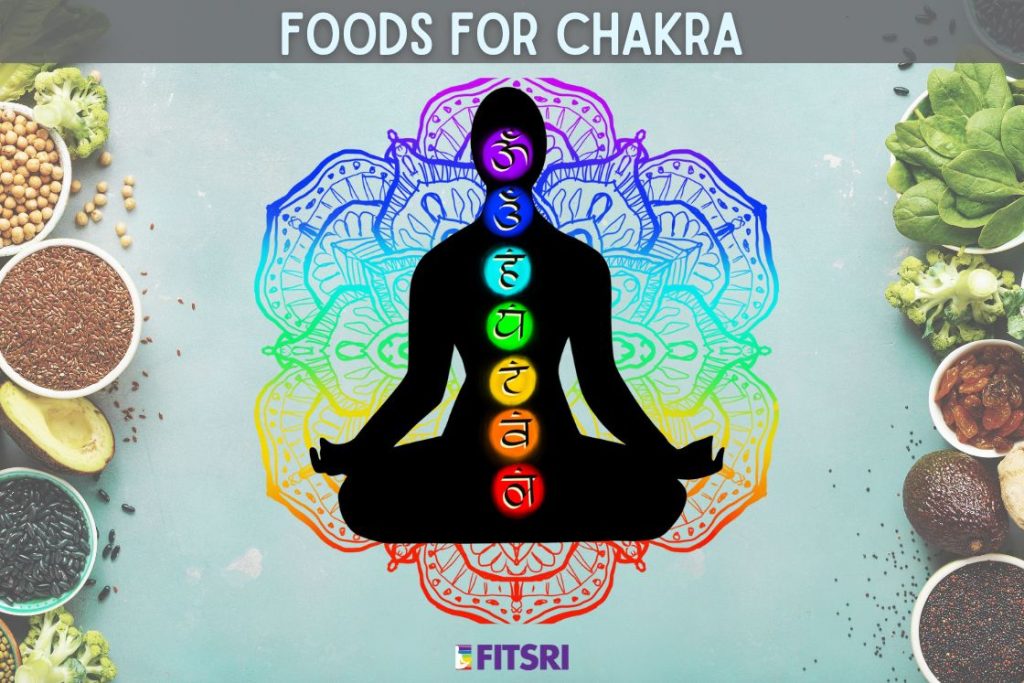
Chakras are the body’s main energy centres, described in yoga and Ayurveda as wheels of energy that influence our physical, emotional, and spiritual health. Each of the seven chakras is linked with specific qualities, colours, and vibrations. When a chakra is out of balance, it can affect both mind and body, and one of the simplest ways to support them is through the foods we eat.
Certain foods are believed to carry energies that align with a particular chakra, helping to restore balance and vitality. For example, grounding root vegetables are often linked with the Root Chakra, while colourful fruits may support the higher chakras. Though not a scientific system, many people find that eating with chakra awareness adds a mindful and nourishing layer to their daily diet.
Importance of balancing chakras for mental, physical, and spiritual health
Have you ever felt out of balance for no clear reason? According to chakra philosophy, this could be linked to blocked or imbalanced energy centres. When chakras are not aligned, the effects can be felt on multiple levels:
- Mental Health: An imbalanced chakra can lead to feelings of anxiety, confusion, or lack of focus.
- Physical Health: The Chakras have a very close relationship with all our bodily systems. An imbalanced Chakra can manifest in our body as fatigue, pain, or even illness.
- Spiritual Health: A blocked chakra can make us feel disconnected from our purpose or the world around us.
Balancing the chakras helps restore harmony between mind, body, and spirit, supporting overall well-being and vitality.
Foods play a role in balancing and energizing each chakra
What we eat does more than just fuel the body it also influences our energy centres, or chakras. Each chakra is linked with certain types of foods, and by including them in our daily diet, we can bring balance and vitality to these energy points. For example, grounding foods can help stabilise the root chakra, while light and refreshing foods can support the crown chakra’s clarity.
Matching food colour with chakra colour
Understanding the connection between food and chakra colour isn’t just about the mystical or energetic components. There’s actually a biological and nutritional foundation to it. Let’s explore this connection.
1. Phytonutrients and colour
The colour of fruits and vegetables often signals the presence of unique phytonutrients. These compounds support different body functions. For example, lycopene in red tomatoes is a powerful antioxidant. Eating foods that match chakra colours may provide the exact nutrients your body needs for those areas of energy.
2. Absorption spectrum and cells
On a biological level, different colours in foods mean they absorb different spectrums of light. Our cells, in turn, are known to absorb these spectrums and utilize light energy. By consuming foods that match with chakra colours, we might be helping our body absorb a spectrum of light energy that resonates with the specific chakra.
3. Targeted nutrition
Each chakra is connected to specific body parts and functions. By choosing foods that match a chakra’s colour, you can give targeted support to those areas. For instance, the throat chakra (blue) is tied to communication. Blue foods like blueberries are rich in antioxidants that support the brain and may improve pathways linked to expression and clarity.
4. Digestive harmony
Different foods affect digestion in different ways. Foods aligned with chakra colours may naturally bring digestive balance. For example, leafy greens like kale and spinach (heart chakra, green) are packed with fibre and chlorophyll, both of which improve digestion and support heart health.
Best foods for each chakra
Now that you know how food colour and chakras connect, let’s explore the best foods for each chakra. This will help you make mindful choices that not only nourish your body but also harmonise your energy flow.
1. Foods for root chakra
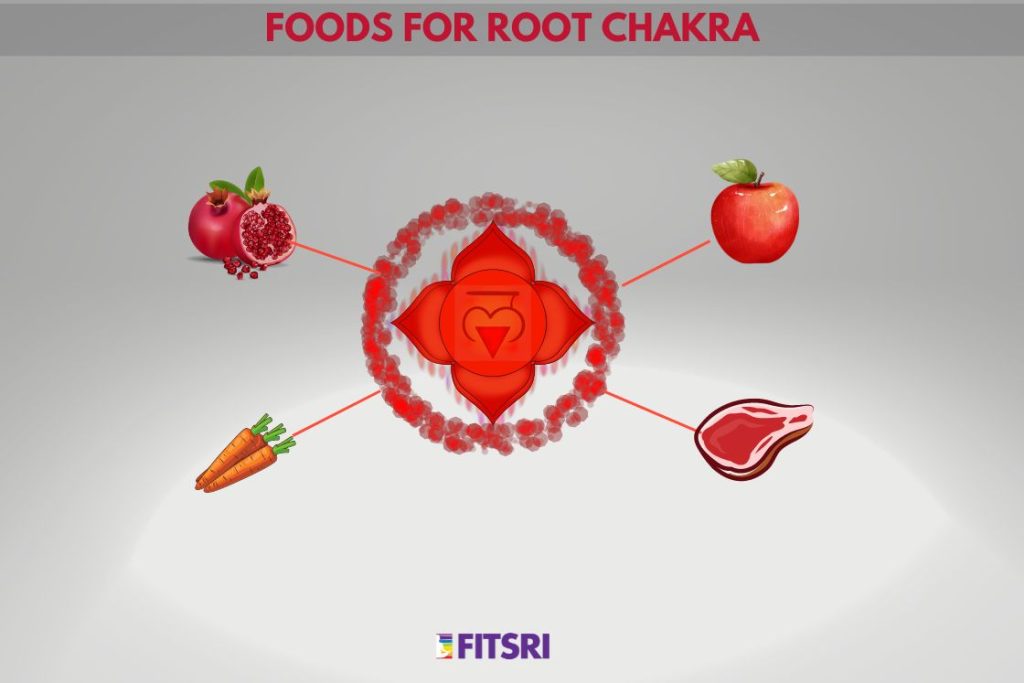
Position: Base of the spine.
Color: Red
Primary Function: The Root Chakra, also known as the Muladhara Chakra, serves as the foundation of our energy system. Its primary function is to ground us and create a sense of security and connection with the world around us.
Signs of Imbalance: When the Root Chakra is imbalanced, you may experience:
- Anxiety or fear without a clear cause.
- A feeling of disconnection from your surroundings.
- A lack of stability and security in your life.
Foods to Balance the Root Chakra: To restore balance to your Root Chakra, consider incorporating the following foods into your diet:
- Root Vegetables: Root vegetables like carrots, beets, and potatoes have a strong connection to the Earth and can help ground your energy.
- Proteins: Lean meats, tofu, and beans provide the necessary building blocks for strength and stability.
- Red Fruits: Fruits such as apples and pomegranates, which share the color red with the Root Chakra, can reinforce its energy.
Explaining the Food-Chakra Connection: The Root Chakra’s connection to our foundation makes it resonate with foods that grow underground, such as root vegetables. Proteins play a role in building physical strength and stability, which is consistent with the function of the chakra. Red fruits, which reflect the color of the chakra, help amplify its energy.
An Example Dish for the Root Chakra: A simple but effective dish to strengthen the Muladhara chakra is roasted root vegetables. Take your favorite root vegetables, cut them into cubes, toss them in olive oil and spices, and roast them until they become tender and delicious. Combine it with a lean source of protein, and you have a meal that will not only delight your taste buds, but also balance and ground your root chakra, promoting a sense of security and stability in your life.
2. Foods for sacral chakra(svadhisthana chakra)

Position: Just below the belly button.
Color: Orange
Primary Function: The Sacral Chakra, known as Svadhisthana, is located just below the navel. It serves as the center of creativity, emotions, and our ability to connect with others. This chakra determines how we deal with our emotions and the emotions of others.
Signs of Imbalance: When your Svadhisthana Chakra is out of balance, you may experience:
- Emotional instability or feeling overwhelmed.
- A lack of creativity or passion.
- Challenges in forming or maintaining personal relationships.
Foods to Balance the Sacral Chakra: To support and balance your Sacral Chakra, consider incorporating the following foods into your diet:
- Orange Foods: Foods like carrots, oranges, and mangoes, which share the color orange with the Sacral Chakra, can help energize and align this center.
- Seeds: Particularly flaxseeds and pumpkin seeds, which are believed to support reproductive health—an aspect linked to this chakra.
- Nuts: Focus on almonds and walnuts, which provide nourishment for the emotional and creative aspects associated with the Sacral Chakra.
Explaining the Food-Chakra Connection: The association of the Svadhisthana Chakra with the color orange suggests that consuming orange foods can help stimulate and balance this energy center. Seeds and nuts are believed to support reproductive health, which is one of the physical aspects connected to the Sacral Chakra.
An Example Dish for the Sacral Chakra: For a snack that resonates with the Svadhisthana Chakra, you can prepare a delicious smoothie bowl. Blend oranges, mangoes and a splash of almond milk until you get a creamy consistency. Pour the smoothie into a bowl and sprinkle with flax seeds, pumpkin seeds and a handful of almonds. This refreshing treat will not only please your taste buds, but will also help balance your Sacral Chakra, boost creativity and increase emotional well-being.
3. Food for solar plexus chakra (manipura chakra)

Position: Upper abdomen, in the stomach area.
Color: Yellow
Primary Function: The Solar Plexus Chakra, known as Manipura, is located in the upper abdomen and encompasses the stomach area. It serves as the core of our personal power, confidence, and control, and plays a significant role in our self-esteem and decision-making ability. This chakra determines our capacity to be proactive and assertive.
Signs of Imbalance: When the Manipura Chakra is imbalanced, you may experience:
- Feelings of powerlessness or low self-worth.
- A tendency to be passive or indecisive.
- Digestive problems or discomfort in the stomach area.
Foods to Balance the Solar Plexus Chakra: To nourish and harmonize your Solar Plexus Chakra, focus on incorporating the following foods into your diet:
- Yellow Foods: Embrace the vibrancy of yellow with foods like bananas, corn, and yellow peppers. Yellow resonates with the color of the Manipura Chakra, amplifying its energy.
- Grains: Whole grains such as quinoa and brown rice act as fuel for your body, providing the energy needed to assert yourself and take proactive actions.
- Dairy Products: Especially yogurt and kefir, as they aid digestion, a function closely tied to the Solar Plexus Chakra. Fermented dairy products are particularly beneficial.
Explaining the Food-Chakra Connection: Choosing yellow foods naturally matches the color of the Manipura chakra and enhances its energy and resonance. Whole grain products serve as a source of sustained energy that facilitates assertiveness and proactive decision-making. Dairy products, especially when fermented, support healthy digestion, which is closely related to the functions of this chakra.
An Example Dish for the Solar Plexus Chakra: For a breakfast that invigorates your Manipura Chakra, consider preparing a yogurt parfait. Layer yogurt with sliced bananas, cooked quinoa, and a drizzle of honey. Sprinkle chia seeds on top for an additional nutritional boost. This energizing and delicious dish not only aligns with the vibrancy of the Solar Plexus Chakra but also promotes self-confidence and proactive decision-making in your day.
4. Foods for heart chakra(anahata chakra)
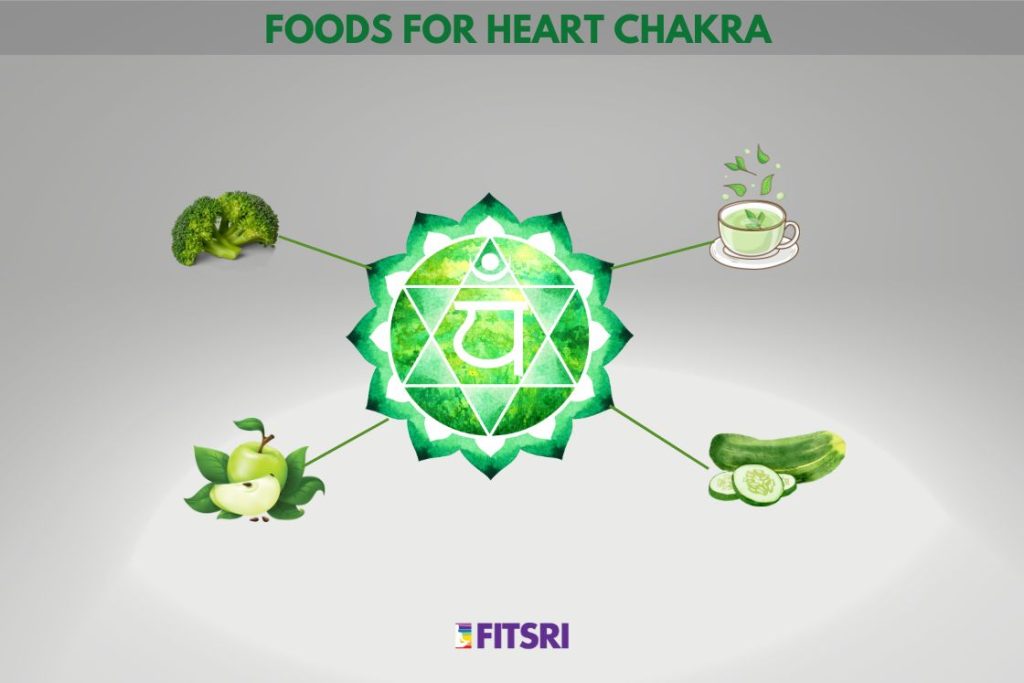
Position: Center of the chest, just above the heart.
Color: Green
Primary Function: The Heart Chakra, known as Anahata, located in the center of the chest, directly above the heart. It is the focal point of love, compassion, and kindness, influencing our emotional connections with others and our capacity for empathy. This chakra also plays a pivotal role in our ability to give and receive love.
Signs of Imbalance: When the Anahata Chakra is out of balance, it can manifest as:
- Difficulties in forming emotional bonds with others.
- Feelings of isolation or detachment.
- An inability to forgive or holding onto grudges.
Foods to Balance the Heart Chakra: To promote balance and harmony within your Heart Chakra, consider incorporating the following foods into your diet:
- Green Foods: Embrace the nourishment of green vegetables like spinach, broccoli, and kale. These foods resonate with the green hue of the Anahata Chakra, enhancing its energy.
- Antioxidant-Rich Foods: Include green tea and berries in your diet. These foods support cardiovascular health, which is closely related to the Heart Chakra’s physical functions.
- Whole Grains: Opt for whole grains such as oats and barley. They provide sustenance and energy, fostering emotional balance and resilience.
Explaining the Food-Chakra Connection: The Anahata Chakra’s green color connects it to green vegetables, which not only provide sustenance but also support and enhance its energy. Antioxidant-rich foods contribute to cardiovascular health because the heart chakra is located near the heart. Whole grains provide nourishment and energy and promote emotional balance and resilience.
An Example Dish for the Heart Chakra: For a Heart Chakra-Friendly meal, prepare a bright green salad with spinach, broccoli and avocado slices. Garnish it with a handful of berries and a vinaigrette of green tea extract and olive oil. Complement this with a warm bowl of oat porridge on the side. This delightful combination not only tantalizes your taste buds but also nourishes and harmonizes your Heart Chakra, allowing love and compassion to flow freely.
5. Foods for throat chakra(vishuddha chakra)
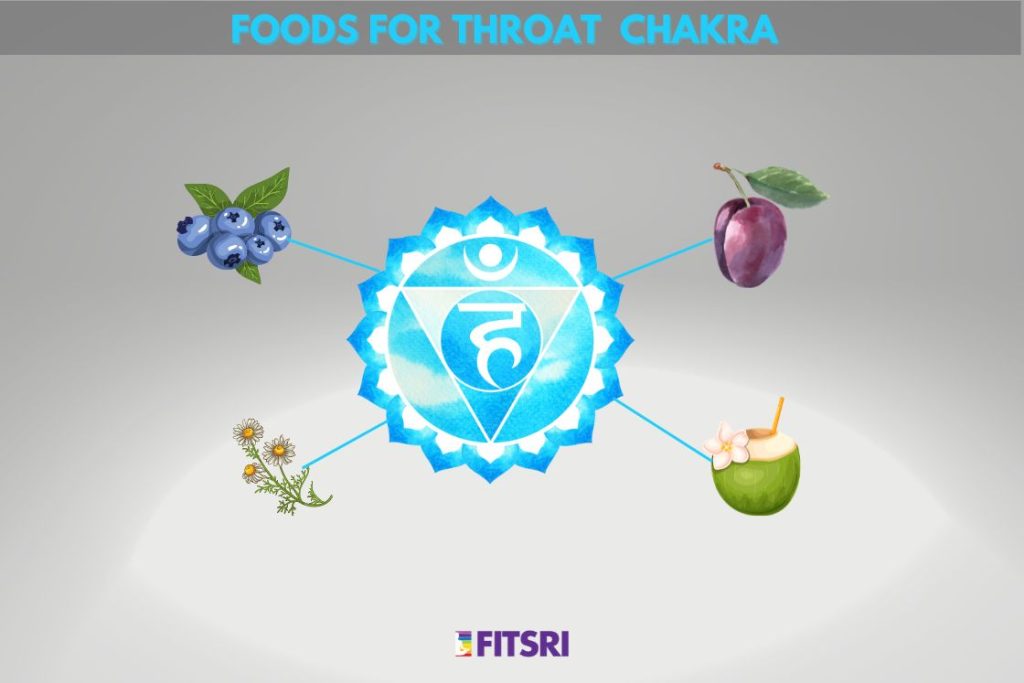
Position: Throat.
Color: Blue
Primary Function: The Throat Chakra, known as Vishuddha, is located in the throat area. It serves as the center of communication, self-expression, and truth, governs our ability to communicate our thoughts, feelings, and ideas with clarity and confidence. This chakra also plays a vital role in effective listening.
Signs of Imbalance: When the Vishuddha Chakra is unbalanced, you may experience:
- Difficulties in communicating or expressing your thoughts and emotions.
- A fear of speaking up or asserting yourself.
- Throat discomfort, such as persistent coughs or a sore throat.
Foods to Balance the Throat Chakra: To foster balance and harmony in your Throat Chakra, consider incorporating the following foods into your diet:
- Blue Foods: Embrace the calming energy of blue with foods like blueberries and blackberries, which resonate with the color of the Vishuddha Chakra, enhancing its energy.
- Omega-3 Rich Foods: Include flaxseeds and chia seeds in your diet. These foods support brain function, aiding in clear and effective communication.
- Herbal Teas: Opt for herbal teas such as chamomile or licorice root, which can be soothing and beneficial for the throat, aligning with the physical aspects of this chakra.
Explaining the Food-Chakra Connection: The Vishuddha Chakra’s association with the color blue makes blue-colored foods an ideal choice for enhancing its energy. Omega-3 rich foods contribute to the functioning of the brain, facilitating clear and confident communication. Herbal teas, especially those with properties that soothe the throat, support the physical aspects of this chakra.
An Example Dish for the Throat Chakra: A revitalizing snack to nurture your Vishuddha Chakra is a blueberry smoothie. Blend together blueberries, a spoonful of flaxseeds, and your preferred milk or yogurt. Enjoy it with along a warm cup of chamomile tea. This combination not only pleases your palate but also strengthens your Throat Chakra, promoting clear and confident communication.
6. Foods for third eye chakra(ajna chakra)
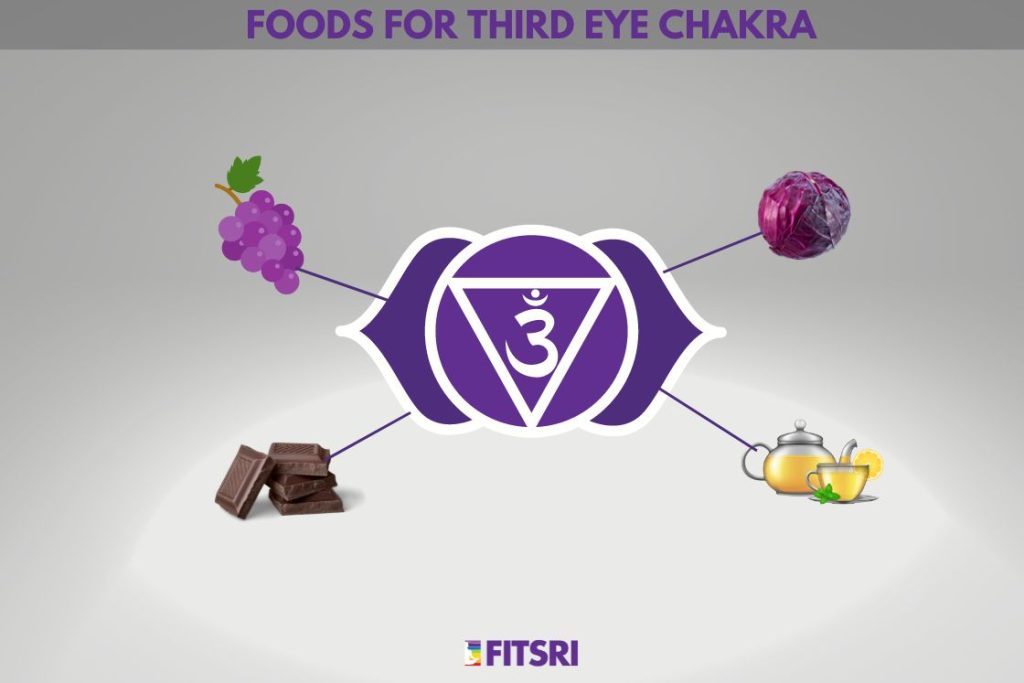
Position: Forehead, just above the space between the eyebrows.
Color: Indigo
Primary Function: The Third Eye Chakra, known as Ajna, is located in the forehead area, just above the space between the eyebrows. It serves as the center of intuition, foresight, and inner wisdom, allowing us to tap into our innate understanding and connect with higher levels of consciousness.
Signs of Imbalance: When the Ajna Chakra is not harmoniously aligned, you may experience:
- Difficulty making decisions or trusting your intuition.
- A sense of disconnection from your inner self.
- Headaches or vision-related issues.
Foods to Balance the Third Eye Chakra: To support and align your Third Eye Chakra, consider incorporating the following foods into your diet:
- Deep Blue or Indigo Foods: Embrace the deep blue or indigo shades with foods like blueberries, figs, and prunes, as they resonate with the color of the Ajna Chakra, enhancing its energy.
- Omega-3 Rich Foods: Include walnuts and fatty fish like salmon, which provide essential nutrients for brain health, enhancing intuition and inner clarity.
- Dark Chocolate and Caffeine (in Moderation): These treats, when consumed in moderation, can stimulate the brain, promoting focus and heightened awareness, supporting the Third Eye Chakra.
Explaining the Food-Chakra Connection: The Ajna Chakra’s deep blue or indigo color makes foods of similar shades ideal for nurturing its energy. Omega-3 rich foods are crucial for brain health and contribute to enhancing intuition and inner clarity. Dark chocolate and moderate caffeine consumption can stimulate the brain, promoting concentration and awareness.
An Example Dish for the Third Eye Chakra: Indulge in a bowl of mixed berries, featuring blueberries, blackberries, and a few sliced figs, for a Third Eye Chakra-enhancing treat. Complement it with a piece of dark chocolate and savor a warm cup of green tea. This delightful combination not only gratifies your taste buds but also nurtures your mind and spirit, promoting intuition and inner wisdom.
7. Foods for crown chakra(sahasrara chakra)
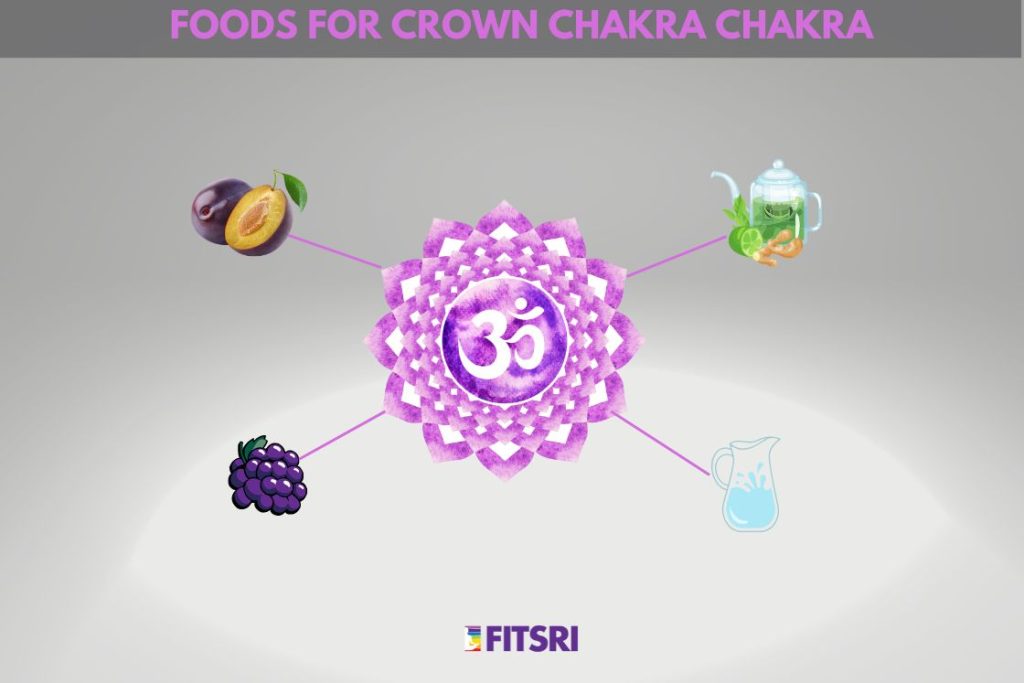
Position: Top of the head, often visualized as a lotus flower opening upwards.
Color: Violet
Primary Function: The Crown Chakra, known as Sahasrara, is located at the top of the head and is often visualized as a lotus flower opening upward. It represents the pinnacle of spiritual awareness, where individual consciousness connects with the universal consciousness, fostering enlightenment, wisdom, and inner peace.
Signs of Imbalance: When the Sahasrara Chakra is out of balance, you may experience:
- Feelings of spiritual disconnection or isolation.
- Overwhelming cynicism or close-mindedness.
- Mental confusion or difficulty focusing.
Foods to Balance the Crown Chakra: While the Crown Chakra is less directly connected to specific foods, its balance is enhanced through mindful and grateful eating. Consider the following practices:
- Sattvic Foods: Embrace light and pure foods such as fresh fruits and nuts, which are believed to promote clarity of mind and purity of spirit.
- Clear Teas and Water: Stay hydrated with clear teas or water infused with herbs or crystals, symbolizing purity and clarity of thought.
- Violet-Hued Foods: Incorporate foods with a naturally violet hue, like purple cabbage or grapes, as they resonate with the traditional color associated with this chakra, connecting it visually and energetically.
Explaining the Food-Chakra Connection: While the Sahasrara Chakra isn’t directly assoicted with food is the lower chakras, the mentioned foods can support your spiritual practice. Sattvic foods are traditionally considered pure and conducive to mental clarity. Clear teas and water represent purity and clarity of thought, while violet-hued foods visually and energetically connect with the chakra’s traditional color.
A Dietary Practice for the Crown Chakra: Enhance your spiritual journey by incorporating a simple meditation practice during meals. Before eating, take a moment to express gratitude for the nourishment before you. As you enjoy each bite, immerse yourself in the flavors and textures. This practice not only aids digestion but also strengthens the connection between your physical body and the spiritual realm, nurturing your Crown Chakra and fostering inner peace and wisdom.
Tips for mindful eating and chakra balancing
1. Intention matters
When it comes to balancing our chakras, eating the right foods is only one piece of the puzzle. Just as important are the energy and intention behind our actions. When you prepare or choose your meal, set a clear intention for the chakra you want to balance. For example, when focusing on the Heart Chakra, remind yourself that you’re eating these foods to promote love and compassion. By connecting your actions to your intention, you strengthen the chakra-balancing effect of the foods you eat.
2. Cultivating a harmonious meal setting
The environment in which we eat can have a significant impact on our digestion and overall energy. Aim for a calm, quiet and harmonious space. This doesn’t mean you need a fancy environment. Just a tidy table, perhaps some soothing music, and leaving out distractions like televisions or smartphones can go a long way. When you create a calm environment, you can better focus on the act of eating and the intention behind it.
3. Blessing and expressing gratitude
Before you consume your meal, take a moment to appreciate where it came from and the journey it took to get to your plate. By honoring the farmers, chefs, and even the earth and sun that played a role in the creation of the food, you foster a deeper connection to your food. You don’t need a lengthy ritual – a simple “thank you” is all it takes. In this way, you not only enhance the energetic qualities of the food, but also align your chakras with frequencies of gratitude and abundance.
Incorporating these mindful practices into your eating routine can make a big difference. Not only will you increase your efforts to balance the chakras, but you’ll also create a richer, more satisfying relationship with the foods you eat.
Conclusion
Balancing our chakras isn’t only a spiritual pursuit, but has tangible effects on our overall well-being. Just as we consciously pay attention to the fuel we put in our car or the updates we install on our devices, our chakras require special nourishment. And one crucial way to provide that nourishment is through our food choices.
What we eat can either align or disrupt our energy centers. While the guide includes specific foods that benefit each chakra, it’s important to remember that everyone’s energy needs can be different. This is where it’s important to tune into your body. Pay attention to how the different foods make you feel, both physically and mentally. If a certain food appeals to you, even if it’s not on the list of recommended foods, trust that instinct. Your body knows what it needs for balance in most cases.
In closing, allow your journey with food to be one of discovery and alignment. May each meal serve not just your body, but your soul, guiding you towards holistic harmony and vibrant health.
Frequently Asked Questions on Food for Chakras
1. How can I increase my chakra energy?
Increasing chakra energy can be achieved through various means such as meditation focused on specific chakras, engaging in physical activities like yoga, consuming foods that resonate with the particular chakra, and using crystals or sound healing techniques. Regular practice and attention to your body’s signals can help amplify this energy.
2. What blocks your chakra?
Chakras can be blocked by various factors including emotional trauma, stress, negative thought patterns, unhealthy diet, lack of physical activity, or even disconnection from one’s environment. Each chakra has its specific vulnerabilities, and recognizing the signs of blockage is the first step to addressing them.
3. Which chakra is papaya good for?
Papaya, with its vibrant orange hue and sweetness, can be particularly beneficial for the Svadhisthana or Sacral Chakra. This chakra is linked to creativity, passion, and emotions. Consuming papaya may help in balancing and activating this energy center.
4. How do you stop chakra blockage?
Preventing chakra blockages involves regular self-care and awareness. This can include meditation, maintaining a balanced diet, engaging in physical activity, emotional healing, seeking therapy when necessary, and avoiding negative influences or environments. Regular chakra check-ins, where you tune into how you feel physically and emotionally, can also help in early detection and prevention.
5. What chakra is protein?
Proteins, being essential for strength and vitality, can be associated with the Muladhara or Root Chakra. This chakra governs our feelings of security, stability, and groundedness. Consuming adequate protein can provide the physical strength and energy that supports a balanced root chakra.
6. Does fasting clear chakras?
Fasting, when done mindfully and safely, can help in clearing out toxins from the physical body and can also offer clarity to the mind. This, in turn, can aid in balancing and clearing the chakras. However, it’s crucial to ensure that fasting is done in a way that suits your body and under guidance if you’re new to it.
7. What chakra is lemon good for?
Lemon, with its bright yellow color and revitalizing taste, resonates with the Manipura or Solar Plexus Chakra. This chakra is centered around personal power, confidence, and vitality. Incorporating lemon into your diet can help energize and balance the solar plexus chakra.
8. What weakens the root chakra?
The root chakra can be weakened by feelings of insecurity, disconnection from one’s surroundings, past traumas, financial instability, or neglecting physical health. Chronic stress, feeling ungrounded, and neglecting basic physiological needs can also contribute to an imbalance in the root chakra.




